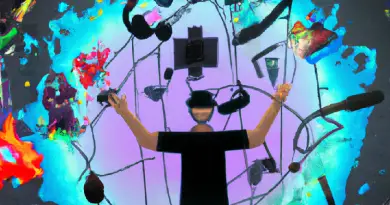The Metaverse’s Role in the Development of Virtual Reality
The metaverse is a virtual world that is created by the convergence of virtually enhanced physical reality and physically persistent virtual space, including the sum of all virtual worlds, augmented reality, and the internet.
Virtual reality (VR) technology has come a long way since its inception in the 1950s. From simple computer simulations to highly immersive virtual worlds, VR has the potential to revolutionize how we interact with computers and the internet. One concept that has gained significant attention in recent years is the idea of the metaverse, a collective virtual shared space that is created by the convergence of virtually enhanced physical reality and physically persistent virtual space, including the sum of all virtual worlds, augmented reality, and the internet. In this article, we will explore the role that the metaverse could play in the development of virtual reality and its potential impact on our daily lives.
What is the Metaverse?
The concept of the metaverse was first introduced in Neal Stephenson’s 1992 science fiction novel Snow Crash, in which the metaverse is described as a virtual reality space where people can interact with each other in a fully immersive and interactive 3D environment. In the years since the book’s publication, the term has been adopted by tech enthusiasts and futurists to describe the potential future of the internet, where virtual reality and the real-world merge to create a new, hybrid environment.
The metaverse is often compared to the Matrix, the virtual reality world depicted in the popular sci-fi film series. However, while the Matrix is a fictional, artificial world created by machines, the metaverse is a collective, shared space that is created by the convergence of physical and virtual reality. In the metaverse, users would be able to interact with each other in real time, regardless of their physical location, and would have the ability to create and customize their own virtual spaces and experiences.
The Potential Impact of the Metaverse
The potential impact of the metaverse on society and the way we live our lives is vast and varied. Some experts believe that the metaverse could serve as a replacement for the internet as we know it, offering a more immersive and interactive experience. Others see the metaverse as a way to bring people together from all over the world, allowing them to connect and collaborate in a virtual space.
One potential use for the metaverse is as a platform for online education and training. Instead of simply reading about a topic or watching a video, students could experience it firsthand in a virtual environment, allowing for a more interactive and engaging learning experience. The metaverse could also be used as a tool for remote collaboration, allowing teams to work together on projects in a virtual space as if they were in the same physical location.
Another potential use for the metaverse is as a platform for entertainment. Users could experience concerts, sporting events, and other live performances in a fully immersive virtual environment, eliminating the need to physically travel to attend these events. The metaverse could also serve as a platform for the creation of virtual theme parks and other interactive experiences, offering a new level of immersion and excitement for users.
Adoption and Development of VR Technology
Before the metaverse can become a reality, there are several hurdles that must be overcome in the development and adoption of VR technology. One of the biggest challenges is the cost and accessibility of VR hardware. Currently, most VR systems require expensive specialized equipment, such as headsets and motion-sensing controllers, which can be a barrier for many consumers. In addition, the content available on VR platforms is often limited, making it difficult for users to find experiences that are engaging and worthwhile. “The industry is growing at a fast pace, with the global VR market size projected to increase from less than 12 billion U.S. dollars in 2022 to more than 22 billion U.S. dollars by 2025.”
Another challenge is the issue of motion sickness, which can occur when the movements and actions in the virtual environment do not match up with the user’s physical movements. This can lead to discomfort and disorientation, which can be a barrier to adoption for some users.
To address these challenges, companies and researchers are working on developing more affordable and user-friendly VR hardware, as well as creating more engaging and diverse content for VR platforms. In addition, efforts are being made to improve the accuracy and responsiveness of VR systems to reduce the risk of motion sickness.
The Role of VR in the Metaverse
While the concept of the metaverse is often associated with VR technology, it is important to note that the metaverse is not limited to VR. In fact, the metaverse could potentially be accessed through a variety of different devices and technologies, including augmented reality (AR), mixed reality (MR), and traditional computer interfaces.
However, VR is likely to play a central role in the development of the metaverse, as it offers the most immersive and interactive experience for users. VR technology allows users to fully immerse themselves in the virtual environment, using their senses and movements to interact with the virtual world in a natural and intuitive way. In the metaverse, VR could be used to create fully immersive virtual spaces and experiences, allowing users to interact with each other and the virtual world in real time.
Conclusion
The concept of the metaverse represents a future in which virtual and physical reality converge to create a new, shared environment. While there are many challenges and limitations to be overcome in the development of VR technology and the metaverse, the potential impact of this technology on society is vast and varied. From education and training to entertainment and collaboration, the metaverse could revolutionize the way we interact with computers and the internet, and change the way we live our lives.



